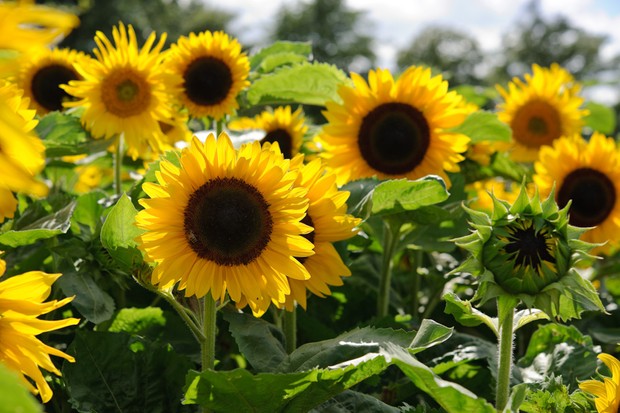
Honeybees visit flowers for two purposes – to collect pollen, which is used to feed the brood, and to collect nectar that can be turned into honey to feed the colony over winter.
There are lots of flowers to grow to attract honeybees, but worker bees show a preference for flowers that give them the highest pollen and nectar rewards. Within the colony, honeybees perform the ‘waggle dance’ to tell other workers where they can find a good pollen or nectar source – so one bee on a flower patch in your garden could attract many more.
To ensure bees find your patch worth visiting, grow plants they’ve been shown to prefer, including those with blue and purple flowers.
Help more pollinators:
Check out our pick of the best flowering plants to grow for honeybees.
Worker bees show a preference for flowers that give them the highest pollen and nectar rewards.
Sunflowers
Sunflowers in bloom
When sunflower heads open, they reveal a bonanza of tiny pollen- and nectar-rich flowers. Discover how to grow sunflowers from start to finish in our sunflower grow guide.
Comfrey

Russian comfrey, Symphytum x uplandicum
Comfrey’s not just great for honeybees, but it also attracts pollinators like bumblebees. These vigorous plants can also be used to make comfrey feed and comfrey ointment.
Salix/willows

Willow catkins on Salix hastata ‘Wehrhahnii’
Willows are a great source of early nectar for early-emerging honeybees. Of course, some willows can grow to enormous proportions, so try a smaller species like Salix caprea or Salix cinerea.
Catmint

Short-stalked catmint, Nepeta subsessilis
Honeybees and other pollinators flock to the small but numerous blooms of catmint plants in droves. They’re a good alternative to lavenders for creating floral hedges, and will produce new flowers more readily when deadheaded.
Hellebores

Corsican hellebore, Helleborus argutifolius, with white-flowered comfrey
Like willows, hellebores are a good source of spring nectar for honeybees. They’re also handy plants for growing in the shadier spots of your garden. Hellebores dislike being moved once planted, so plant them in a permanent spot where bees can enjoy them for years to come.
Spring blossom

Cherry blossom, Prunus avium
Plants with spring blossom to grow include apples, peaches, apricots, cherries and plums, as well as popular choices for wildlife gardens like blackthorn and hawthorn.
Michaelmas daisies

Michaelmas daisy, Symphyotrichum novae-angliae ‘Mrs S.T. Wright’
As summer ends, asters (Michaelmas daisies) burst into bloom, providing a rich source of autumn pollen and nectar for honeybees. Perfect in an autumn border combined with ornamental grasses.
Heathers

White and pink heather (Calluna)
Heathers are compact plants with small but highly rewarding flowers for bees. Calluna species provide nectar from midsummer to autumn, while Erica species are a valuable source of winter nectar.
Wallflowers

Wallflower, Erysimum cheiri, mixed flowers
Honeybees love the easily accessible blooms of wallflowers. All are exceptionally long-flowering, especially ‘Bowles’s Mauve’, which is capable of flowering all year if continually deadheaded.
Centaurea

Honeybee on cornflower, Centaurea cyanus
The Centaurea genus includes a number of species that are popular with bees, including cornflowers (Centaurea cyanus), mountain cornflowers (Centaurea montana) and common knapweed (Centaurea nigra).
Avoid double flowers
When creating a wildlife garden, all pollinators will appreciate single flowers. Double forms often have large, extra petals that render the all-important pollen and nectar inaccessible.

